panasonic SA-PM21PC Service Manual

ORDER NO. MD0501013C1 A6
Specification
n Amplifier Section
FTC Output Power both channel driven 10% total harmonic distortion
20 Hz - 3.5 kHz (Low channel) |
15 W per channel (6 Ω) |
3.5 kHz - 20 kHz (High channel) |
5 W per channel (6 Ω) |
RMS Output Power both channel driven |
|
10% total harmonic distortion |
|
1 kHz (Low channel) |
15 W per channel (6 Ω) |
8 kHz (High channel) |
5 W per channel (6 Ω) |
Total Bi-Amp power |
20 W per channel |
Output impedance |
|
Headphone |
16 Ω - 32 Ω |
n FM Tuner Section |
|
Frequency range |
87.5 MHz -108.0 MHz |
|
(100 kHz step) |
|
87.9 MHz - 107.9 MHz |
|
(200 kHz step) |
Sensitivity |
1.5 µV (IHF) |
S/N 26 dB |
1.25 µV |
Antenna terminals |
75 Ω (unbalanced) |
n AM Tuner Section |
|
Frequency range |
520 kHz - 1710 kHz (10 kHz step) |
Sensitivity |
|
S/N 20 dB (at 1000 kHz) |
500 µV/m |
CD Stereo System
SA-PM21PC
Colour
(S)... Silver Type
n Cassette Deck Section |
|
|
Track system |
4 track, 2 channel |
|
Heads |
|
|
Record/playback |
Solid permalloy head |
|
Erasure |
AC erase head |
|
Motor |
DC servo motor |
|
Recording system |
AC bias 100 kHz |
|
Erase system |
AC erase 100 kHz |
|
Tape speed |
4.8 cm/s (1 7/8 ips) |
|
Overall frequency response (+3 dB, -6 dB) at DECK OUT |
||
NORMAL |
35 Hz - 14 kHz |
|
S/N RATIO |
50 dB (A weighted) |
|
Wow and flutter |
0.08% (WRMS) |
|
Fast forward and rewind time |
Approx. 120 seconds with C-60 |
|
|
|
cassette tape |
n CD Section |
|
|
Disc played |
|
|
CD/MP3/CD-R/RW |
8cm/12cm (3 3/20”/4 73/100”) |
|
Bit rate |
|
|
MP3 |
32kbps - 320kbps |
|
Sampling frequency |
|
|
CD |
44.1 kHz |
|
MP3 |
32 kHz, 44.1 kHz, 48 kHz |
|
Decoding |
16 bit linear |
|
|
|
|
|
© 2005 Matsushita Electric Industrial Co. Ltd.. All |
|
|
rights reserved. |
Unauthorized copying and |
|
distribution is a violation of law. |
|
|
|
|
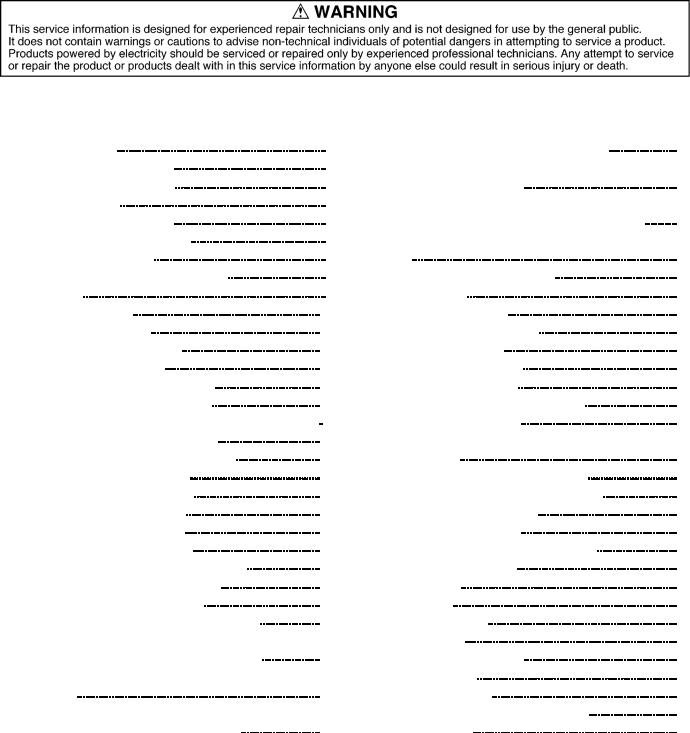
SA-PM21PC |
|
|
Pickup |
|
|
Beam source / wavelength |
Semiconductor laser / 780nm |
|
Number of channels |
Stereo |
|
Wow and flutter |
Below measurable limit |
|
Digital filter |
8 fs |
|
D/A converter |
MASH (1 bit DAC) |
|
Frequency response |
20Hz - 20 kHz (+1dB, -2dB) |
|
n General |
|
|
Power supply |
AC 120 V, 60 Hz |
|
Power consumption |
57 W |
|
Dimensions (W x H x D)
Mass
Power consumption in standby mode
Notes :
1.Specifications are subject to change without notices. Mass and dimensions are approximate.
2.Total harmonic distortion is measured by the digital spectrum analyzer.
n System : SC-PM21PC-S
CONTENTS
|
|
Page |
|
Page |
1 |
Safety Precautions |
4 |
10.19. Procedure for Replacing Cassette Holder |
24 |
|
1.1. GENERAL GUIDELINES |
4 |
10.20. Procedure for Replacing Pinch Roller and Head Block |
|
2 |
Before Repair and Adjustment |
6 |
(Deck Mechanism Unit) |
24 |
3 |
Protection Circuitry |
6 |
10.21. Procedure for Replacing Motor, Capstan Belt A, Capstan |
|
4 |
Handling the Lead-free Solder |
6 |
Belt B, and Winding Belt (Deck Mechanism Unit) |
25 |
|
4.1. About lead free solder (PbF) |
6 |
10.22. Procedure for Replacing Parts on Deck Mechanism PCB |
|
5 |
Precaution of Laser Diode |
7 |
|
27 |
6 |
Handling Precautions For Traverse Deck |
8 |
10.23. Handling of cassette tape jam |
27 |
7 |
Accessories |
9 |
11 Service Positions |
29 |
8 |
Operation Procedures |
10 |
11.1. Checking procedure |
29 |
9 |
Information on CD & MP3 |
11 |
11.2. Checking the major P.C.B. |
29 |
10 |
Assembling and Disassembling |
12 |
12 Self Diagnostic Function |
30 |
10.1. Disassembly flow chart |
12 |
10.2. Disassembly of Side Panel L & R |
13 |
10.3. Disassembly of Top Cabinet Unit |
13 |
10.4. Disassembly of Deck Mechanism and Tape Eject P.C.B 13 |
|
10.5. Disassembly of Headphone P.C.B |
14 |
10.6. Disassembly of Front Panel Assembly |
14 |
10.7. Disassembly of Panel P.C.B |
15 |
10.8. Disassembly of Rear Cabinet |
15 |
10.9. Disassembly of Tuner Pack |
15 |
10.10. Disassembly of Main P.C.B |
16 |
10.11. Disassembly of Power P.C.B |
16 |
10.12. Disassembly of Speaker Terminal P.C.B |
17 |
10.13. Disassembly of Transformer P.C.B |
17 |
10.14. Disassembly of CD Mechanism |
18 |
10.15. Checking Procedure for Each Major P.C.B. |
19 |
10.16. Procedures of Replacing Traverse Base (Unit), Driving |
|
Gear, and Cam Gear (CD Mechanism Unit) |
19 |
10.17. Procedures for Replacing Optical Pickup (CD Mechanism
Unit) |
22 |
10.18. Procedures for Replacement Traverse Gear A and |
|
Traverse Gear B (CD Mechanism Unit) |
23 |
|
12.1. Self-diagnosis Function |
30 |
|
12.2. Clearing all error code |
32 |
|
12.3. Cancelling the Self-Diagnostic mode |
32 |
|
12.4. Setting of doctor mode |
32 |
13 |
Procedure for Checking Operation of Individual Parts of Deck |
|
|
Mechanism Unit |
37 |
|
13.1. Operation Check with Cassette Tape |
37 |
|
13.2. Operation Check without Cassette Tape |
37 |
14 |
Measurement And Adjustments |
39 |
|
14.1. Cassette Deck Section |
39 |
15 |
Voltage Measurement and Waveform Chart |
41 |
|
15.1. Voltage Measurement |
41 |
|
15.2. Waveform |
43 |
16 |
Block Diagram |
44 |
|
16.1. CD Servo Block |
44 |
|
16.2. Main Block |
46 |
17 |
Notes of Schematic Diagram |
50 |
18 |
Schematic Diagram |
51 |
|
18.1. CD Servo Circuit |
51 |
|
18.2. Main Circuit and Tuner Extent Circuit |
53 |
|
18.3. Panel Circuit |
57 |
2
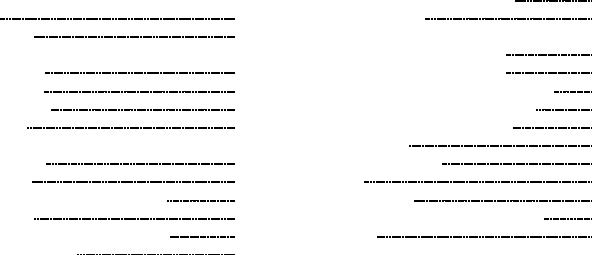
|
|
|
|
SA-PM21PC |
18.4. Deck Circuit, Deck Mechanism Circuit and Tape Eject |
|
21 |
Illustration of IC , Transistors and Diodes |
72 |
Circuit |
58 |
22 |
Terminal Function of IC s |
73 |
18.5. Power Circuit |
60 |
|
22.1. IC702 (MN6627953HB) Servo processor/ Digital signal |
|
18.6. Transformer Circuit, Headphone Circuit and Speaker |
|
|
processor/ Digital filter/ D/A converter |
73 |
Terminal Circuit |
61 |
|
22.2. IC703 (BA5948FPE2) IC 4CH DRIVE |
74 |
19 Printed Circuit Board |
62 |
|
22.3. IC803 (MN101C49GHA) MICRO PROCESSOR |
75 |
19.1. CD Servo P.C.B. |
62 |
23 |
Troubleshooting Flowchart (CD Section Circuit) |
76 |
19.2. Main P.C.B. |
63 |
24 |
Parts Location and Replacement Parts List |
78 |
19.3. Tuner Extent P.C.B, Headphone P.C.B and Speaker |
|
|
24.1. Deck Mechanism |
79 |
Terminal P.C.B. |
65 |
|
24.2. CD Loading Mechanism |
81 |
19.4. Panel P.C.B. |
66 |
|
24.3. Cabinet |
83 |
19.5. Deck P.C.B and Deck Mechanism P.C.B. |
67 |
|
24.4. Electrical Part List |
86 |
19.6. Power P.C.B. |
68 |
|
24.5. Packaging Materials & Accessories Parts List |
92 |
19.7. Transformer P.C.B and Tape Eject P.C.B. |
69 |
|
24.6. Packaging |
92 |
20 Wiring Connection Diagram |
70 |
|
|
|
3
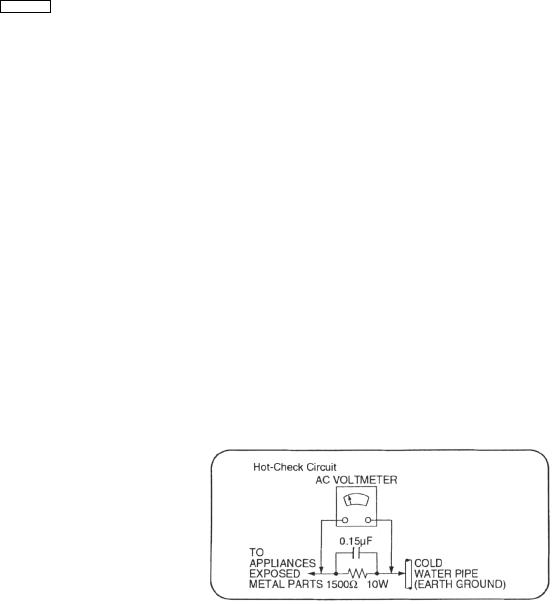
SA-PM21PC
1 Safety Precautions
1.1.GENERAL GUIDELINES
1.When servicing, observe the original lead dress. If a short circuit is found, replace all parts which have been overheated or damaged by the short circuit.
2.After servicing, ensure that all the protective devices such as insulation barriers, insulation papers shields are properly installed.
3.After servicing, check for leakage current checks to prevent from being exposed to shock hazards.
(This “Safety Precaution” is applied only in U.S.A.)
1.Before servicing, unplug the power cord to prevent an electric shock.
2.When replacing parts, use only manufacturer’s recommended components for safety.
3.Check the condition of the power cord. Replace if wear or damage is evident.
4.After servicing, be sure to restore the lead dress, insulation barriers, insulation papers, shields, etc.
5.Before returning the serviced equipment to the customer, be sure to make the following insulation resistance test to prevent the customer from being exposed to a shock hazard.
1.1.1.LEAKAGE CURRENT COLD CHECK
1.Unplug the AC cord and connect a jumper between the two prongs on the plug.
2.Using an ohmmeter measure the resistance value, between the jumpered AC plug and each exposed metallic cabinet part on the equipment such as screwheads, connectors, control shafts, etc. When the exposed metallic part has a return path to the chassis, the reading should be between 1MΩ and 5.2Ω.
When the exposed metal does not have a return path to the chassis, the reading must be  .
.
Fig. 1
1.1.2.LEAKAGE CURRENT HOT CHECK (See Figure 1.)
1.Plug the AC cord directly into the AC outlet. Do not use an isolation transformer for this check.
2.Connect a 1.5kΩ, 10 watts resistor, in parallel with a 0.15µF capacitors, between each exposed metallic part on the set and a good earth ground such as a water pipe, as shown in Figure 1.
3.Use an AC voltmeter, with 1000 ohms/volt or more sensitivity, to measure the potential across the resistor.
4.Check each exposed metallic part, and measure the voltage at each point.
5.Reverse the AC plug in the AC outlet and repeat each of the above measurements.
6.The potential at any point should not exceed 0.75 volts RMS. A leakage current tester (Simpson Model 229 or equivalent) may be used to make the hot checks, leakage current must not exceed 1/2 milliamp. should the measurement is outside of the limits specified, there is a possibility of a shock hazard, and the equipment should be repaired and re-checked before it is returned to the customer.
4
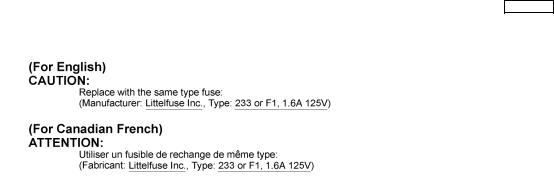
SA-PM21PC
1.1.3.Caution for fuse replacement
5

SA-PM21PC
2 Before Repair and Adjustment
Disconnect AC power, discharge Power Supply Capacitors C839 & C840 through a 10Ω, 1W resistor to ground.
DO NOT SHORT-CIRCUIT DIRECTLY (with a screwdriver blade, for instance), as this may destroy solid state devices. After repairs are completed, restore power gradually using a variac, to avoid overcurrent.
· Current consumption at AC 120 V, 60 Hz in NO SIGNAL mode should be ~200 mA.
3 Protection Circuitry
The protection circuitry may have operated if either of the following conditions are noticed:
·No sound is heard when the power is turned on.
·Sound stops during a performance.
The function of this circuitry is to prevent circuitry damage if, for example, the positive and negative speaker connection wires are "shorted", or if speaker systems with an impedance less than the indicated rated impedance of the amplifier are used.
If this occurs, follow the procedure outlines below:
1.Turn off the power.
2.Determine the cause of the problem and correct it.
3.Turn on the power once again after one minute. Note:
When the protection circuitry functions, the unit will not operate unless the power is first turned off and then on again.
4 Handling the Lead-free Solder
4.1.About lead free solder (PbF)
Distinction of PbF P.C.B.:
P.C.B.s (manufactured) using lead free solder will have a PbF stamp on the P.C.B.
Caution:
·Pb free solder has a higher melting point than standard solder; Typically the melting point is 50 - 70°F (30 - 40°C) higher. Please use a high temperature soldering iron. In case of soldering iron with temperature control, please set it to 700 ± 20°F (370 ± 10°C).
·Pb free solder will tend to splash when heated too high (about 1100°F/600°C).
·When soldering or unsoldering, please completely remove all of the solder on the pins or solder area, and be sure to heat the soldering points with the Pb free solder until it melts enough.
6

SA-PM21PC
5 Precaution of Laser Diode
CAUTION:
This unit utilizes a class 1 laser.
Invisible laser radiation is emitted from the optical pickup lens.
When the unit is turned on:
1.Do not look directly into the pick up lens.
2.Do not use optical instruments to look at the pick up lens.
3.Do not adjust the preset variable resistor on the pickup lens.
4.Do not disassemble the optical pick up unit.
5.If the optical pick up is replaced, use the manufacturer’s specified replacement pick up only.
6.Use of control or adjustments or performance of procedures other than those specified herein may result in hazardous radiation exposure.
CAUTION!
THIS PRODUCT UTILIZES A LASER.
USE OF CONTROLS OR ADJUSTMENTS OR PERFORMANCE OF PROCEDURES OTHER THAN THOSE SPECIFIED HEREIN MAY RESULT IN HAZARDOUS RADIATION EXPOSURE.
7
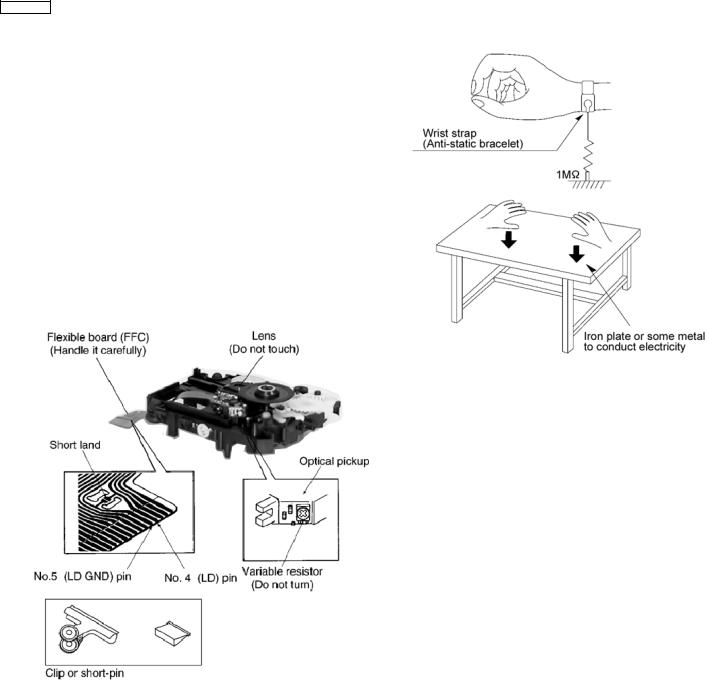
SA-PM21PC
6 Handling Precautions For Traverse Deck
The laser diode in the traverse deck (optical pickup) may break down due to potential difference caused by static electricity of clothes or human body.
So, be careful of electrostatic breakdown during repair of the traverse deck (optical pickup).
l Handling of CD traverse deck (optical pickup)
1.Do not subject the traverse deck (optical pickup) to static electricity as it is extremely sensitive to electrical shock.
2.The short land between the No.4 (LD) and No.5 (GND) pins on the flexible board (FFC) is shorted with a solder build-up to prevent damage to the laser diode.
3.Take care not to apply excessive stress to the flexible board (FFC board) (Fig 6.1).
4.Do not turn the variable resistor (laser power adjustment). It has already been adjusted.
Fig 6.2
Caution when Replacing the Optical Pickup :
The traverse has a short point shorted with solder to protect the laser diode against electrostatics breakdown. Be sure to remove the solder from the short point before making connections.
Fig 6.1
l Grounding for electrostatic breakdown prevention
1.Human body grounding (Fig 6.2)
Use the anti-static wrist strap to discharge the static electricity from your body.
2.Work table grounding (Fig 6.2)
Put a conductive material (sheet) or steel sheet on the area where the traverse deck (optical pickup) is placed, and ground the sheet.
Caution :
The static electricity of your clothes will not be grounded through the wrist strap. So, take care not to let your clothes touch the traverse deck (optical pickup).
8
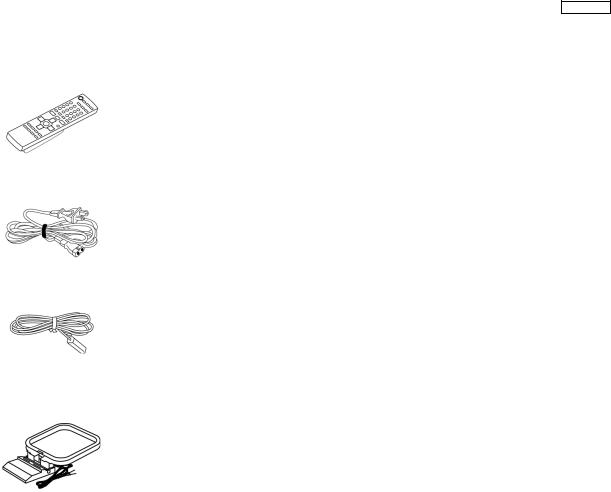
SA-PM21PC
7 Accessories
Note : Refer to Packing Materials & Accessories (Section 24.5) for part number.
Remote control
AC cord
FM indoor antenna
AM loop antenna
9
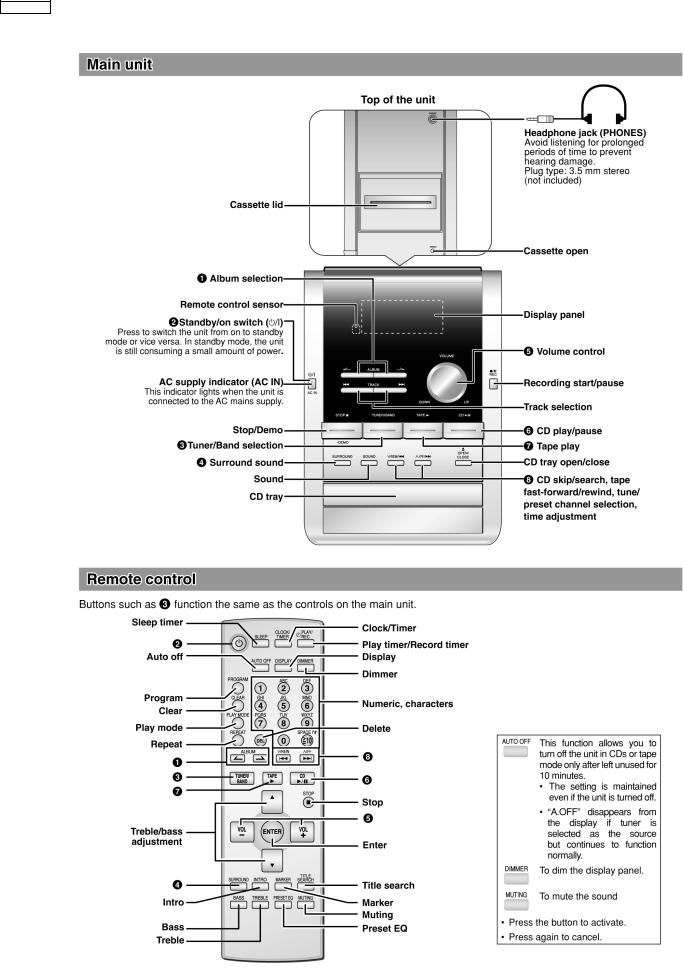
SA-PM21PC
8 Operation Procedures
10
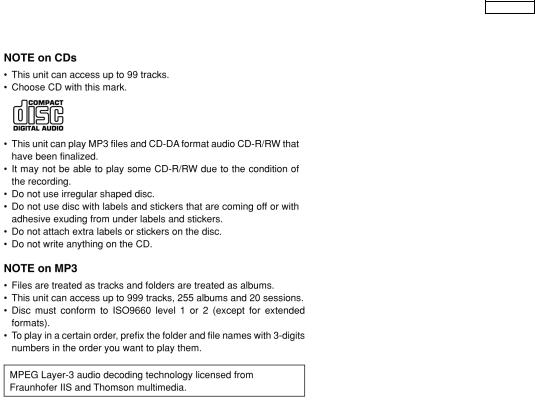
SA-PM21PC
9 Information on CD & MP3
11
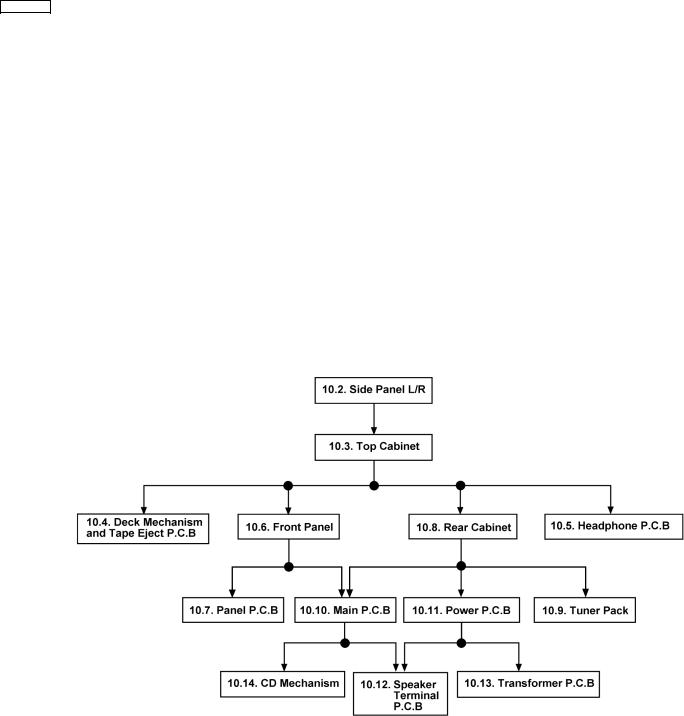
SA-PM21PC
10 Assembling and Disassembling
“ATTENTION SERVICER”
Some chassis components may be have sharp edges. Be careful when disassembling and servicing.
1.This section describes procedures for checking the operation of the major printed circuit boards and replacing the main components.
2.For reassembly after operation checks or replacement, reverse the respective procedures. Special reassembly procedures are described only when required.
3.Select items from the following index when checks or replacement are required.
Warning:
This product uses a laser diode. Refer to “Precaution of Laser Diode”.
10.1. Disassembly flow chart
The following chart is the procedure for disassembling the casing and inside parts for internal inspection when carrying out the servicing.
To assemble the unit, reverse the steps shown in the chart below.
12
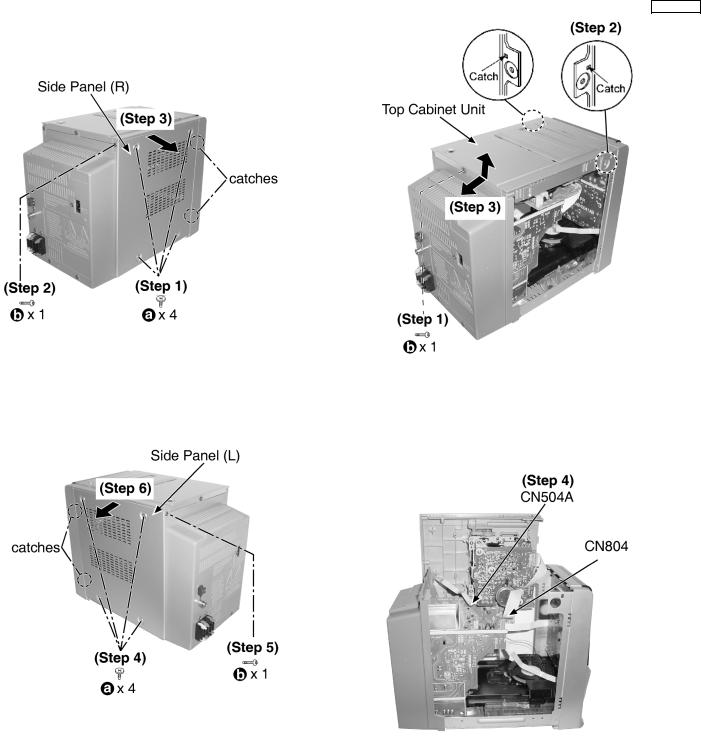
10.2.Disassembly of Side Panel L & R
Step 1 : Remove 4 screws. Step 2 : Remove 1 screw.
Step 3 : Remove the side panel (R) as arrow shown (Be careful of the catches).
Step 4 : Remove 4 screws. Step 5 : Remove 1 screw.
Step 6 : Remove the side panel (L) as arrow shown (Be careful of the catches).
10.3.Disassembly of Top Cabinet Unit
· Follow the (Step 1) - (Step 6) of Item 10.2.
SA-PM21PC
Step 1 : Remove 1 screw.
Step 2 : Release catches at both ends.
Step 3 : Lift up the top cabinet unit, push backward as arrow shown and flip top cabinet unit sideway.
Step 4 : Detach the connectors CN504A and FFC CN804.
10.4.Disassembly of Deck Mechanism and Tape Eject P.C.B
·Follow the (Step 1) - (Step 6) of Item 10.2.
·Follow the (Step 1) - (Step 4) of Item 10.3.
13

SA-PM21PC
Step 1 : Remove 1 screw.
Step 2 : Release the clutch.
Step 3 : Remove 4 screws.
Step 4 : Push the lever as arrow shown to open the cassette lid and remove the deck mechanism unit.
10.5.Disassembly of Headphone P.C.B
·Follow the (Step 1) - (Step 6) of Item 10.2.
·Follow the (Step 1) - (Step 4) of Item 10.3.
Step 1 : Remove 1 screw.
Step 2 : Release the clutch.
10.6.Disassembly of Front Panel Assembly
·Follow the (Step 1) - (Step 6) of Item 10.2.
·Follow the (Step 1) - (Step 4) of Item 10.3.
Step 1 : Detach the connector CN900B .
14
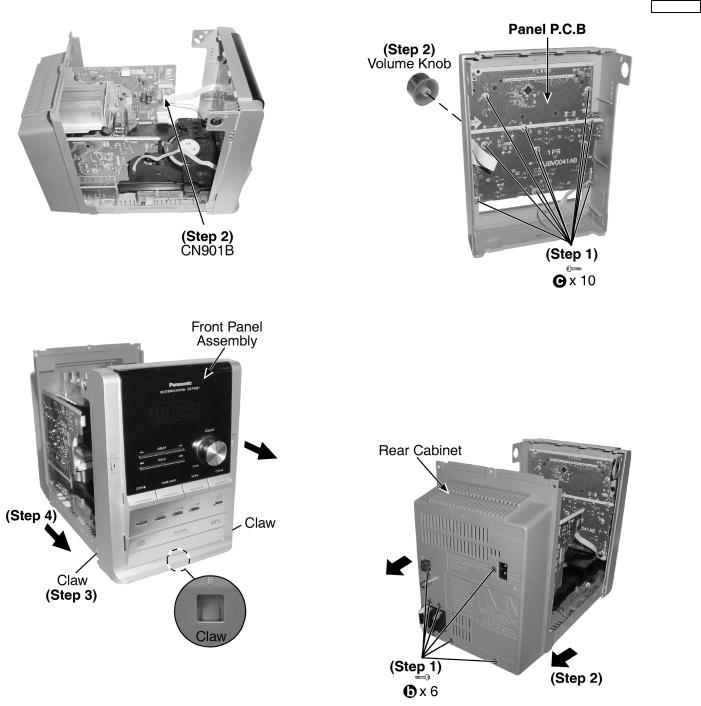
SA-PM21PC
Step 2 : Detach the FFC CN901B.
Step 3 : Release 3 Claws.
Step 4 : Remove the front panel assembly as arrow shown.
10.7. Disassembly of Panel P.C.B
·Follow the (Step 1) - (Step 6) of Item 10.2.
·Follow the (Step 1) - (Step 4) of Item 10.3.
·Follow the (Step 1) - (Step 4) of Item 10.6.
Step 1 : Remove 10 screws.
Step 2 : Remove the Volume Knob.
10.8. Disassembly of Rear Cabinet
·Follow the (Step 1) - (Step 6) of Item 10.2.
·Follow the (Step 1) - (Step 4) of Item 10.3.
Step 1 : Remove 6 screws.
Step 2 : Remove the rear cabinet as arrow shown.
10.9. Disassembly of Tuner Pack
·Follow the (Step 1) - (Step 6) of Item 10.2.
·Follow the (Step 1) - (Step 4) of Item 10.3.
·Follow the (Step 1) - (Step 2) of Item 10.8.
15
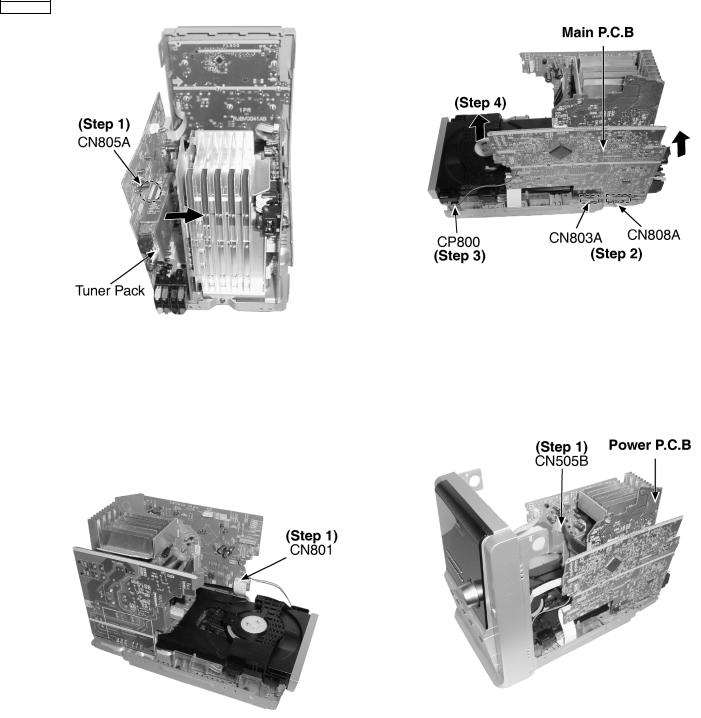
SA-PM21PC
Step 1 : Detach the connector CN805A and remove the tuner pack as arrow shown.
10.10. Disassembly of Main P.C.B
·Follow the (Step 1) - (Step 6) of Item 10.2.
·Follow the (Step 1) - (Step 4) of Item 10.3.
·Follow the (Step 1) - (Step 4) of Item 10.6.
·Follow the (Step 1) - (Step 2) of Item 10.8.
Step 1 : Detach the FFC CN801.
Step 2 : Detach the connector CN803A, CN808A. Step 3 : Detach the connector CP800.
Step 4 : Remove the Main P.C.B as arrow shown.
10.11. Disassembly of Power P.C.B
·Follow the (Step 1) - (Step 6) of Item 10.2.
·Follow the (Step 1) - (Step 4) of Item 10.3.
·Follow the (Step 1) - (Step 2) of Item 10.8.
Step 1 : Detach the connector CN505B.
16
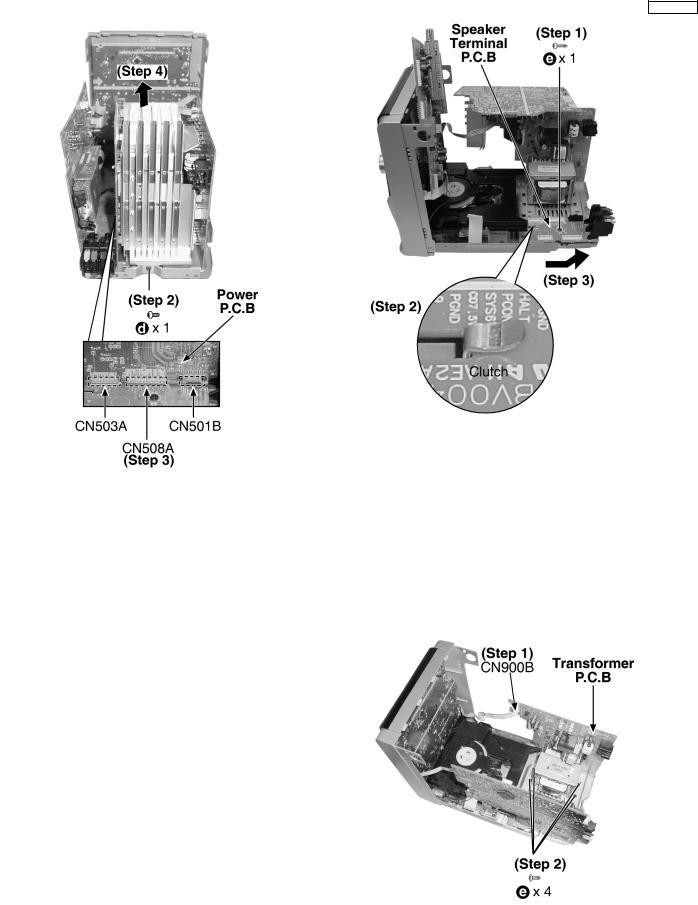
SA-PM21PC
Step 2 : Remove 1 screw.
Step 3 : Detach the connector CN503A, CN508A, CN501B. Step 4 : Remove the Power P.C.B as arrow shown.
10.12.Disassembly of Speaker Terminal P.C.B
·Follow the (Step 1) - (Step 6) of Item 10.2.
·Follow the (Step 1) - (Step 4) of Item 10.3.
·Follow the (Step 1) - (Step 2) of Item 10.8.
·Follow the (Step 1) - (Step 2) of Item 10.10.
·Follow the (Step 2) - (Step 4) of Item 10.11.
Step 1 : Remove 1 screw. Step 2 : Release the clutch.
Step 3 : Remove the Speaker Terminal P.C.B as arrow shown.
10.13.Disassembly of Transformer P.C.B
·Follow the (Step 1) - (Step 6) of Item 10.2.
·Follow the (Step 1) - (Step 4) of Item 10.3.
·Follow the (Step 1) - (Step 2) of Item 10.8.
·Follow the (Step 1) - (Step 4) of Item 10.11.
Step 1 : Detach the connector CN900B.
Step 2 : Remove 4 screws.
17
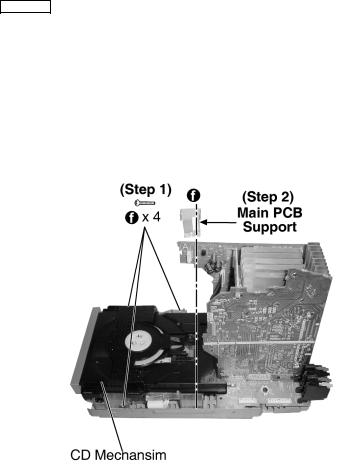
SA-PM21PC
10.14.Disassembly of CD Mechanism
·Follow the (Step 1) - (Step 6) of Item 10.2.
·Follow the (Step 1) - (Step 4) of Item 10.3.
·Follow the (Step 1) - (Step 4) of Item 10.6.
·Follow the (Step 1) - (Step 2) of Item 10.8.
·Follow the (Step 1) - (Step 4) of Item 10.10.
Step 1 : Remove 4 screws.
Step 2 : Remove the Main P.C.B Support.
18

10.15.Checking Procedure for Each Major P.C.B.
10.15.1.Replacement of the Power Amplifier IC
·Replacement of the Power Amplifier IC
·Follow the (Step 1) - (Step 6) of Item 10.2.
·Follow the (Step 1) - (Step 4) of Item 10.3.
·Follow the (Step 1) - (Step 2) of Item 10.8.
·Follow the (Step 1) - (Step 4) of Item 10.11.
Step 1 Remove 5 screws.
Step 2 Unsolder the terminals of Power Amp IC (IC300, IC500) and replace the component.
Step 3 Unsolder the terminals of Transistor (Q503) and replace the component.
SA-PM21PC
10.16.Procedures of Replacing Traverse Base (Unit), Driving Gear, and Cam Gear (CD Mechanism Unit)
10.16.1. Disassembly of the Disc Tray.
·Follow the (Step 1) - (Step 6) of Item 10.2.
·Follow the (Step 1) - (Step 4) of Item 10.3.
·Follow the (Step 1) - (Step 4) of Item 10.6.
·Follow the (Step 1) - (Step 2) of Item 10.8 .
·Follow the (Step 1) - (Step 4) of Item 10.10.
·Follow the (Step 1) - (Step 2) of Item 10.14.
19
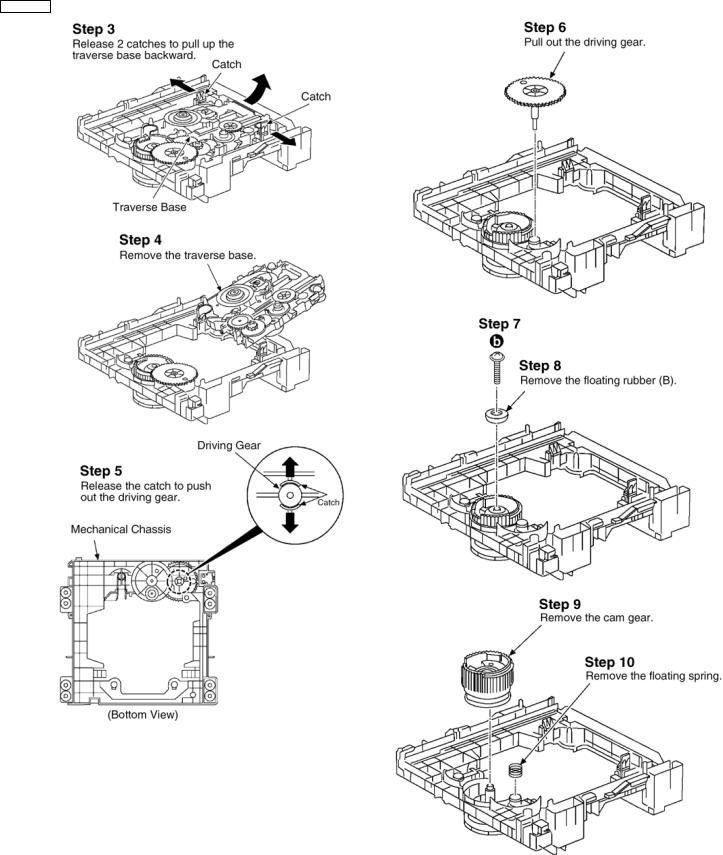
SA-PM21PC
20
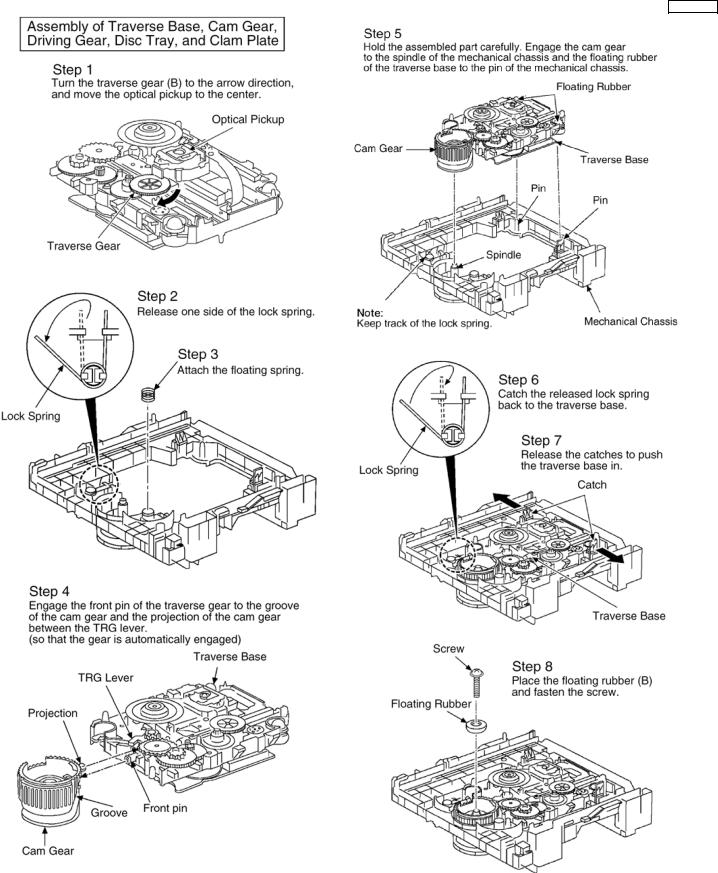
SA-PM21PC
21
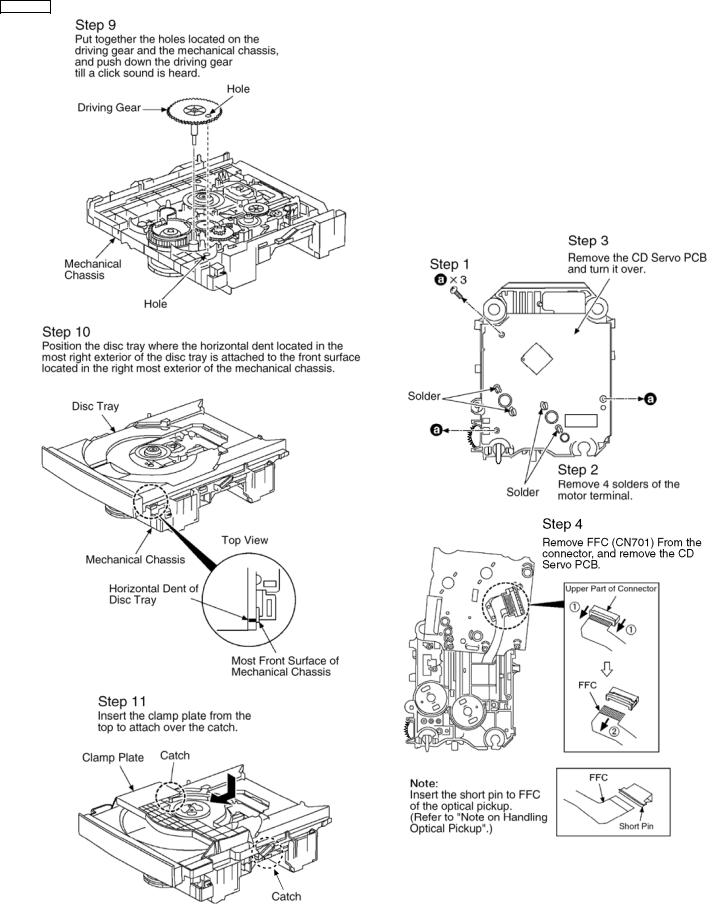
SA-PM21PC
10.17. Procedures for Replacing Optical Pickup (CD Mechanism Unit)
· Follow the (Step 1) - (Step 6) of Item 10.2.
· Follow the (Step 1) - (Step 4) of Item 10.3.
· Follow the (Step 1) - (Step 4) of Item 10.6.
· Follow the (Step 1) - (Step 2) of Item 10.8.
· Follow the (Step 1) - (Step 4) of Item 10.10.
· Follow the (Step 1) - (Step 2) of Item 10.14.
· Follow the (Step 1) - (Step 4) of Item 10.16.1.
22

SA-PM21PC
10.18.Procedures for Replacement Traverse Gear A and Traverse Gear B (CD Mechanism Unit)
·Follow the (Step 1) - (Step 6) of Item 10.2.
·Follow the (Step 1) - (Step 4) of Item 10.3.
·Follow the (Step 1) - (Step 4) of Item 10.6.
·Follow the (Step 1) - (Step 2) of Item 10.8.
·Follow the (Step 1) - (Step 4) of Item 10.10.
·Follow the (Step 1) - (Step 2) of Item 10.14.
·Follow the (Step 1) - (Step 2) of Item 10.16.1.
23

SA-PM21PC
10.19.Procedure for Replacing Cassette Holder
·Follow the (Step 1) - (Step 6) of Item 10.2.
·Follow the (Step 1) - (Step 4) of Item 10.3.
·Follow the (Step 1) - (Step 4) of Item 10.4.
10.20. Procedure for Replacing Pinch Roller and Head Block (Deck Mechanism Unit)
· Follow the (Step 1) - (Step 6) of Item 10.2.
· Follow the (Step 1) - (Step 4) of Item 10.3.
24
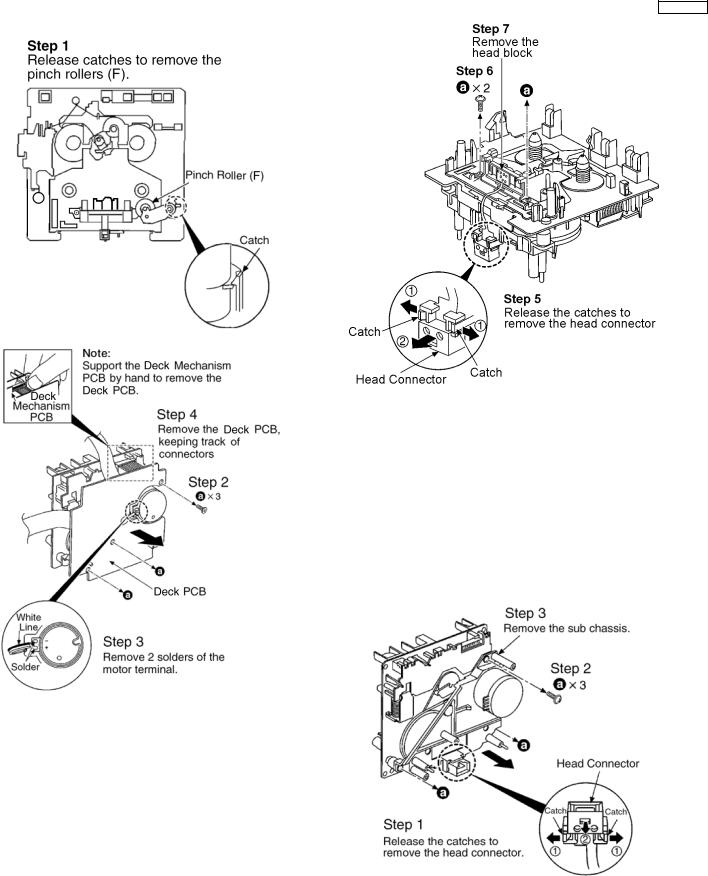
SA-PM21PC
· Follow the (Step 1) - (Step 4) of Item 10.4.
10.21. Procedure for Replacing Motor, Capstan Belt A, Capstan Belt B, and Winding Belt (Deck Mechanism Unit)
· Follow the (Step 1) - (Step 6) of Item 10.2.
· Follow the (Step 1) - (Step 4) of Item 10.3.
· Follow the (Step 1) - (Step 4) of Item 10.4.
· Follow the (Step 1) - (Step 4) of Item 10.20.
25

SA-PM21PC
26

SA-PM21PC
10.22. Procedure for Replacing Parts on Deck Mechanism PCB
· Follow the (Step 1) - (Step 6) of Item 10.2.
· Follow the (Step 1) - (Step 4) of Item 10.3.
· Follow the (Step 1) - (Step 4) of Item 10.4.
10.23. Handling of cassette tape jam
· Follow the (Step 1) - (Step 6) of Item 10.2.
27
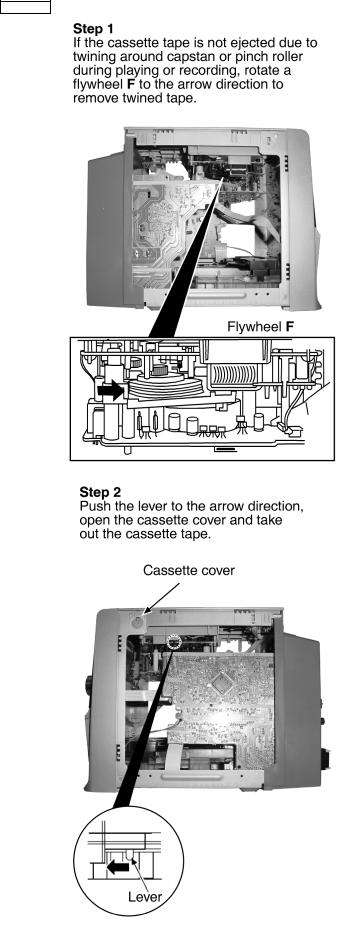
SA-PM21PC
28
